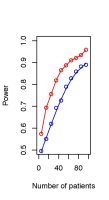It has been reported that as few as 2% to 3% of patients enroll in clinical trials.[1] When we consider that a 2020 Health Information National Trends Survey found that 85% of U.S.-based adults utilize health or wellness applications, and 80% are willing to share data from at-home devices,[2] it suggests that technological advancements in clinical studies are the cornerstone to decentralizing the clinical research journey and expanding clinical trial equity.
Technological advancements in all aspects of work and life are moving at lightning, and the ophthalmic clinical research space is following suit to improve processes for sponsors, investigators and patients. Improved quality of imaging and diagnostic modalities, as well as tools that allow for entirely novel measurements to be taken are only a few examples of the ever-developing advancements in clinical research tools.
There is excitement surrounding the trajectory of product sponsors, contract research organizations (CROs) and clinics in advancing clinic trial processes to bring potentially life-changing therapies to patients in need. With this, the importance of decentralizing clinical studies to obtain more robust data points and reduce patient burden is essential in pushing clinical research forward successfully. Addressing the growing need to develop clinical studies that assess patients’ signs and symptoms and track drug regimen compliance in a more effective manner should be a major focus.
In many areas of the world today, including developed countries, patients do not have access to health care, including investigative therapies that could change their lives and, in the case of ophthalmology, their vision. One major restraint for patient participation in desired studies includes transportation barriers.[3] Some patients do not have access to adequate means of transport or live far from the nearest clinical research site. The importance of remote technologies comes into play here, enhancing clinical research access and outreach for these patients.
Technology Is Key to Decentralizing the Clinical Trial Landscape
It is crucial that remote technologies produce quality data of a similar, non-inferior nature to tests performed in the office—or more optimal quality. Furthermore, it would be particularly beneficial if technologies produced repeated measures in one quick and easy process. For example, devices capable of measuring ocular redness, tear film instability, including tear break up time (TBUT), and areas of fluorescein staining on a single examination could be extensively beneficial to clinical trials in the dry eye or ocular allergy space.
Enhancing accuracy within clinical studies should be a major consideration in the development of remote technologies to decentralize ophthalmic clinical trials. Measurements taken by participants in their homes should be time-stamped to ensure precision of data points. Reminders for drop regimens and other measurements that enhance patient compliance should also be considered when creating these remote devices. With consistent reminders for patients to take photos, videos or enter their signs and symptoms into a device diary, many more data points can be obtained in a clinical study. This in turn increases the statistical power of a clinical trial (Figure 1), allowing for greater understanding of how a drug works throughout the course of the day and aiming to bring therapies to market more effectively.

Figure 1: Power and sample size requirement for a hypothetical clinical trial employing novel diagnostic modalities (e.g.: anterior segment imaging or retinal function) as primary endpoint. In both scenarios, it is assumed that the trial lasts eight weeks and all parameters, except the frequency of testing, are held constant. Models are based upon linear mixed effects regression. Blue: assuming patients are tested weekly in the office. Note that for a statistical power of 80% or 90%, the minimum number of patients should be approximately 60 and 100, respectively. Red: assuming patients are tested daily (whether from home or in a general practice or mobile unit). Note that for a statistical power of 80% or 90%, the minimum number of patients should be approximately 40 and 60, respectively. This represents a meaningful reduction in costs, in addition to making the trial more accessible to the population affected by the disease of interest.
In the posterior segment space, technologies able to assess early changes in age-related macular degeneration (AMD) and diabetic retinopathy (DR) are essential, as there are no current treatments for early stages of these diseases and limited methods to assess how these highly prevalent conditions affect vision-related quality of life. Developing technologies that can target visual function changes over time with increased sensitivity in patients with early AMD and DR is a major need in ophthalmic clinical research with potentially meaningful impact in drug development. These technologies could also help identify patients at greater risk of progressing to more severe forms of the disease, who would benefit most from early intervention. Moreover, by enriching the trial with patients experiencing more rapid disease progression, it is possible to improve the statistical power to detect clinically significant changes in shorter duration trials.
Utilizing a technology that can assess visual function and be used by patients at home is truly warranted for retina research. A device that allows patients to self-administer efficiently and remotely allows for significantly more data points when assessing early disease progression and developing therapies that may treat or slow progression of AMD and DR to more advanced and visually threatening stages.
Patients Are The Cornerstone Of These Trials
When developing technologies to decentralize clinical studies, patients must be top of mind in all stages of the process. Easy-to-follow instructions for at-home devices used in clinical studies are essential, especially for older demographics.
Many patients, especially in the posterior segment space, are left to believe that there is nothing that can be done for their ocular condition. The goal for ophthalmic clinical research is to bring vision and life-changing therapies to these patients. Remote technologies may be the tools required to assess visual function and progressive changes in a patient’s vision over time due to its natural history or as a result of an investigative therapy. As stated previously, technological advancements that support decentralization of clinical trials provide significantly more data points than measurements taken in-office and may be the answer to strengthening statistical power and proving the efficacy and safety of therapeutics globally. For instance, drugs that failed to reach a statistically significant endpoint in pivotal trials that employed office-based measurements (e.g. ocular redness) could have been successful in demonstrating improvement in symptoms at home or in the office, which are more relevant to patients’ quality-of-life.
Along with at-home measurements and testing abilities, remote devices can be used in-clinic at lower costs and shorter duration times, thus helping with clinic workflow. The duration of study visits is one key limiting factor for patient recruitment and retention in a trial. Therefore, the utilization of user-friendly technologies by clinic staff could reduce waiting times while still providing assessments of high quality.
Make Research More Accessible To A Larger Scale Of Participants
With remote technologies, it is recommended that artificial intelligence (AI) through an automated system is employed to assess the quality of images and videos in real-time, so that a patient can be notified to re-do any needed measurements. Coupling remote devices with AI-enabled technologies could also help improve the repeatability of measurements and reduce variability, which is key to improving the statistical power of a trial. In addition, instead of relying on human gradings, which are often time-consuming and can slow enrollment, AI-based algorithms can provide accurate measurements in real-time and accelerate the efforts to screen eligible patients for a trial.
By decentralizing clinical studies, there is growing hope that the clinical trial experience will improve for patients, as well as welcome patients who are located further from clinical research sites. Patients will have fewer in-office visits to attend and in turn will be more willing to consider participation in clinical trials that can benefit not only themselves, but others suffering from the same ophthalmic conditions around the world.
Increase the Number of Data Points
In addition to improving access to clinical trials, remote devices allow researchers and clinicians to monitor signs and symptoms outside office hours and outside of the clinic environment. Investigators may gain a better understanding of how ocular diseases, such as dry eye syndrome or ocular allergies, truly affect patients’ quality of life in the real-world, including when they wake up, work on the computer and go to sleep. Visual function measurements taken throughout the day vastly increase data points for a posterior segment clinical trial and can provide significantly more information than testing done less frequently in-office.
Improving clinical trial equity can help close the gap between the challenges to enroll and retain patients in clinical trials and the growing burden of ocular diseases. All in all, there are immense benefits to creating and providing remote technologies for clinical trial participants. This improved subject experience allows us to reach and attract a larger population of patients. Along with this, the use of remote devices can provide significantly more data points for clinical trials, specifically in the ophthalmology space, enhancing statistical power, increasing the likelihood of a successful trial and potentially contributing to the availability of needed therapies.
[1] Unger JM, Vaidya R, Hershman DL, Minasian LM, Fleury ME. Systematic Review and meta-analysis of the magnitude of structural, clinical, and physician and patient barriers to cancer clinical trial participation. JNCI: Journal of the National Cancer Institute. 2019;111(3):245-255. doi:10.1093/jnci/djy221
[2] Clinical Trials: Bringing Cancer Research to All Possible Participants. National Cancer Institute. https://www.cancer.gov/research/annual-plan/scientific-topics/clinical-trials. Accessed August 9, 2022.
[3] Unger, JM, et al.







